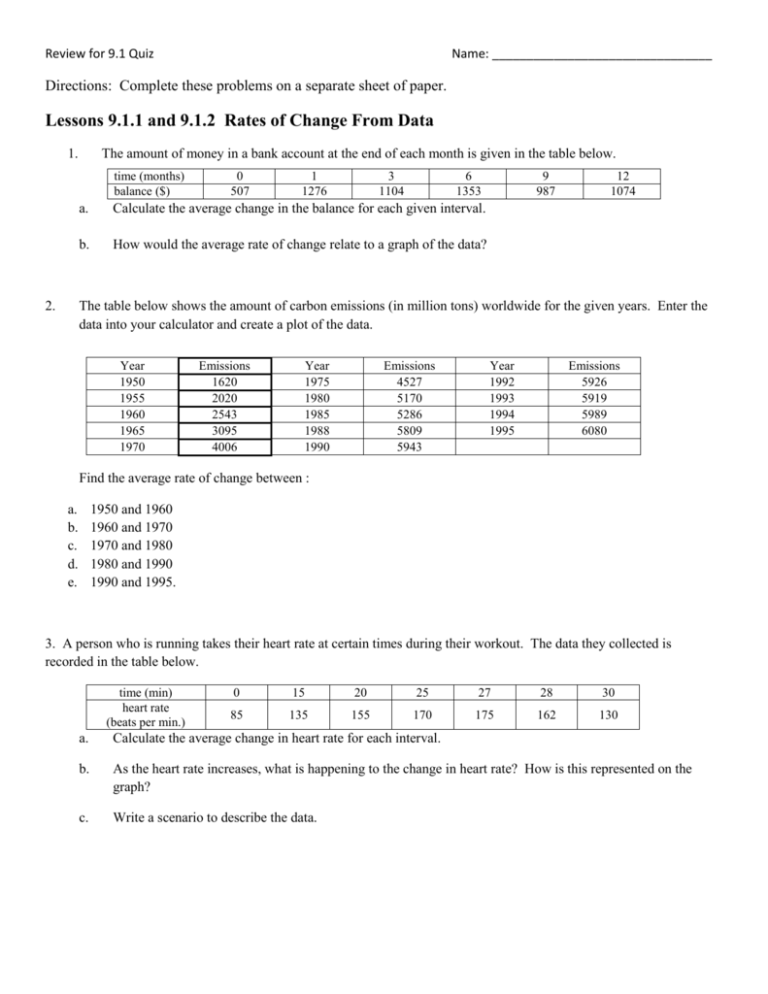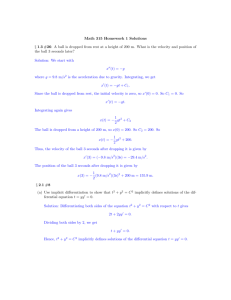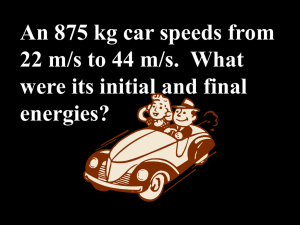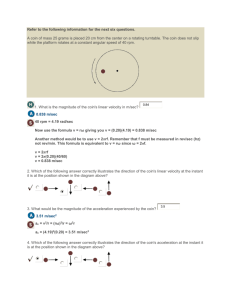Lessons 9.1.1 and 9.1.2 Rates of Change From Data
advertisement

Review for 9.1 Quiz Name: ________________________________ Directions: Complete these problems on a separate sheet of paper. Lessons 9.1.1 and 9.1.2 Rates of Change From Data 1. The amount of money in a bank account at the end of each month is given in the table below. time (months) balance ($) 2. 0 507 1 1276 3 1104 6 1353 a. Calculate the average change in the balance for each given interval. b. How would the average rate of change relate to a graph of the data? 9 987 12 1074 The table below shows the amount of carbon emissions (in million tons) worldwide for the given years. Enter the data into your calculator and create a plot of the data. Year 1950 1955 1960 1965 1970 Emissions 1620 2020 2543 3095 4006 Year 1975 1980 1985 1988 1990 Emissions 4527 5170 5286 5809 5943 Year 1992 1993 1994 1995 Emissions 5926 5919 5989 6080 Find the average rate of change between : a. b. c. d. e. 1950 and 1960 1960 and 1970 1970 and 1980 1980 and 1990 1990 and 1995. 3. A person who is running takes their heart rate at certain times during their workout. The data they collected is recorded in the table below. time (min) heart rate (beats per min.) 0 15 20 25 27 28 30 85 135 155 170 175 162 130 a. Calculate the average change in heart rate for each interval. b. As the heart rate increases, what is happening to the change in heart rate? How is this represented on the graph? c. Write a scenario to describe the data. Lessons 9.1.3 and 9.1.4 Slope, Average Velocity, and Rates of Change 1. 2. A car travels such that its distance from home is d(t) 3t 2 2 miles for t 1 to t 7 hours of travel. a. Calculate the average rate of change for each 1-hour interval. b. Use the information from part (a) to find a formula for the velocity of the car at any time t. A ball is thrown off the top of a building and lands on the ground below. The function h(t) 16t 2 64t 48 gives the ball’s height in feet with respect to time in seconds. 3. a. When will the ball hit the ground? b. Make a table of time versus height. Use 1-second increments. Use the table to sketch a graph of the function over the interval that fits this situation. c. Find the average velocity for each 1-second time interval that the ball is in the air. d. What is happening to the average velocity of the ball with respect to the time? e. What does the average velocity tell you about the change in position of the ball? A rocket is launched off of a platform such that its height is determined by the function h(t) 16t 2 128t 4 , where time is in seconds. a. When will the rocket hit the ground? b. Make a table of time versus height. Use 1-second increments. Use the table to sketch a graph of the function over the interval that fits this situation. c. Find the average velocity for each 1-second time interval that the ball is in the air. d. What is happening to the average velocity of the ball with respect to the time? e. What does the average velocity tell you about the change in position of the ball? 4. Determine the average rate of change for the function 2x 2 x between x 3 and x 3 h . Simplify your answer completely. 5. Determine the average rate of change for the function f (x) x 2 6x between x 2 and x 2 h . Simplify your answer completely. 6. Determine the average rate of change for the function f (x) 1x 2x between x 5 and x 5 h . Simplify your answer completely. 7. A man standing on a bridge drops a coin into a water fountain from a height of 105 ft. The height of the coin with respect to time is given by the function h(t) 105 16t 2 , where t is in seconds and t 0 . Find the average speed of the coin for the first 2 seconds after it is dropped. What is the average speed of the coin between 2 seconds and the time it takes to hit the water?










